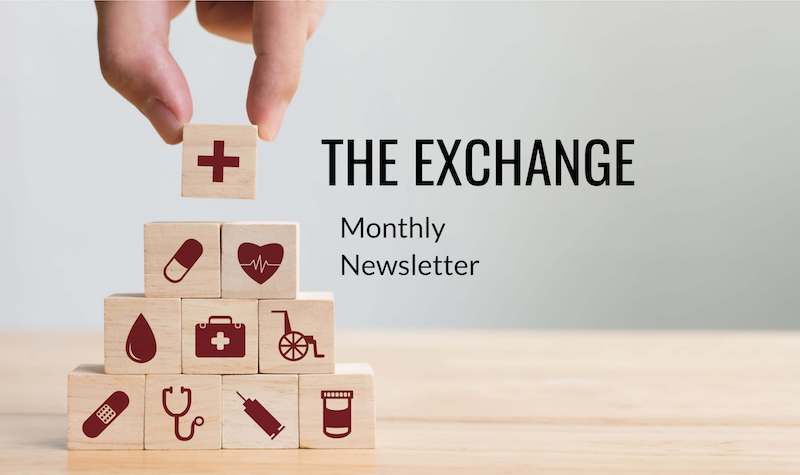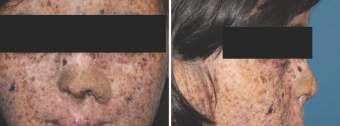THE EXCHANGE | Newsletter December 2019

Sculpting the Perfect Nose
When do you advise rhinoplasty?
There are two subsets of people who seek advice for, and need rhinoplasty (nose job). One set of patients is unhappy with the way their nose looks without any inciting cause or history of injury. These patients may be unhappy with the overall appearance of their nose and want improvement for aesthetic reasons. These patients need cosmetic (aesthetic) rhinoplasty. There is a second subset of patients whose nose has a deformed appearance due to previous injury, birth defects or due to surgical excision of nose tumors. These patients need reconstructive rhinoplasty to restore the normal shape.
What makes reconstructive rhinoplasty challenging?
Nose is situated at the center of the face and has high aesthetic value. It also plays an important role in breathing. Its three-dimensional anatomy makes reconstruction very challenging both functionally and cosmetically.
How do you manage patient expectations in cosmetic rhinoplasty?
Proper counselling is the key. Concerns of the patient are understood and realistic expectations are set with them. If the patient is clear about what changes they want made to their nose, rhinoplasty can be a life changing experience.
How has rhinoplasty evolved over years?
Reconstructive rhinoplasty has been practiced for a very long time. In olden days, nose amputation was a common practice, as a punishment, in the Indian subcontinent. Indian surgeons, therefore, are considered the pioneers of nasal reconstruction. One variety of nasal reconstruction is even named as Indian rhinoplasty.
The procedure, however, has evolved a lot over the years. These days, we use advanced scanning (3D scans) and software mechanism to virtually plan a surgery even before performing it. A very close outcome can also be predicted using technology.
Can you briefly describe the procedure?
In cosmetic rhinoplasty, the nose shape is altered by reshaping the supporting structures of nose through incision given inside the nose (nasal passages).
In reconstructive rhinoplasty where there is loss of skin, supporting structures and nasal passages, all these need to be reconstructed by using similar tissue from elsewhere in the body such as forehead, cheek, forearm or ribs.
Can you share a challenging case?
Very recently we did a reconstructive rhinoplasty for a 12-year-old. He was suffering from a congenital condition called Xeroderma Pigmentosa. This condition predisposes the individual to multiple skin conditions in the sun exposed parts. He had a cancer of the nose. (Figure-1)

The treatment involved removal of most of the lower part of the nose. The defect (Figure-2) was so extensive

that it was not possible to use cheek or forehead skin for reconstruction. Reconstruction of the skin and nasal passages was done by taking skin from the forearm along with tiny blood vessels which were joined to similar blood vessels in the face. The supporting framework of the nose was made by shaping a rib taken from the chest. The patient was satisfied with the overall outcome. (Figure-3)

https://www.medanta.org/dr-vimalendu-brijesh/
https://www.medanta.org/dr-rakesh-kumar-khazanchi/
Fetal Echocardiography
Fetal echo is a type of ultrasound investigation done in pregnant women to check for the wellbeing of heart of the unborn baby. Not all pregnant women are required to undergo a fetal echo investigation. There are certain indications in which the investigation is recommended. These could be either related to the expectant mother, unborn baby or family of the fetus.

Maternal indications:
- Mother having heart disease
- Exposure to certain teratogenic drugs
- Exposure to alcohol and smoking
- Exposure to radiation
- Diabetic mothers
- Mother having diseases like rubella, lupus
Fetal indications:
- Abnormal heart beats or heart structure on level II scan
- Hydrops
- Associated other organ anamolies
- Syndromic fetus
Family indication:
Any congenital heart disease in parents or sibling of unborn.
Fetal echo can diagnose structural, functional and rhythm abnormalities in unborn baby. Depending upon the findings, the family can be counseled about the further line of management. This could vary from elective abortion in very severe cases of heart defect in fetus to just a medical follow up in relatively benign cardiac defects.
Fetal echo can also help in deciding about the method of delivery, timing of delivery and place of delivery keeping in mind the severity of heart defect, its post-natal course and the need of tertiary care level centre.
Certain rhythm abnormalities in fetus, if detected during pregnancy, can be better treated with medicines for a successful outcome.
The ideal time to perform fetal echocardiography is between 18-20 weeks of pregnancy. If performed before 16 weeks, the structures may not have adequately formed and windows may be poor. Beyond 24 weeks, rib shadows of fetus may obscure the imaging.
It is preferable that the study be performed by a qualified pediatric cardiologist. However, radiologists who have adequate experience with fetal echo and fetal circulation can also perform the test.
A high-end ultrasound machine is required for fetal echo. Moreover specialized ultrasound probes are required to image the fetus and delineate the structures.
At Medanta - Gurugram, our expert pediatric cardiologists use the most advanced Philips IE33 machine and specialized fetal probe to do the investigation.

https://www.medanta.org/dr-amit-misri/
Recognition for Mission TB Free Haryana
At the 50th Union World Conference on Lung Health, an annual conference organized by the International Union Against Tuberculosis and Lung Disease (The Union), Medanta was recognized for its commitment to reducing the tuberculosis burden. Dr Bornali Datta, the project lead for Mission TB Free Haryana, received the award for Medanta’s consistent work in this area over the last five years and the institution’s commitment to expanding the work to other states, besides Haryana.
As part of the mission, 25,000 individuals have been screened over the last six years, and 2,870 have been initiated on the DOTS therapy.

https://www.medanta.org/tb-free-haryana/
Technologies that Improve Patient Experience
The healthcare industry is increasingly focusing on creating a better patient experience and improving patient satisfaction. But while many efforts must center on improving interpersonal relationships between doctors and patients, doctors can also tap health technologies to improve the patient experience.
Our healthcare system, with all of its complexities, puts high burden on the already troubled patient. Responsible for selecting a doctor, seeking appointment, and reaching out to the doctor in between appointments, the patient experiences several pain points which can be addressed through technology. Some such must-have technology tools include:
Patient Portal
A patient portal can be a platform to create electronic health record for your patients. This can give you and your patient quick access to historical data including prescriptions, lab test reports and imaging reports. Several technology firms offer solutions which can be customized and deployed as per your needs. Integrating a direct messaging feature in the portal can help you respond to emergency queries, clarify doubts and build rapport with your patients.
Digitizing Appointment Scheduling
Online appointment scheduling can take multiple forms, including a personal website, a mobile app or listing on an aggregator. This helps patients in booking appointments conveniently. However, that should not discount the presence of a teleoperator who can still book appointments for patients who are not digitally savvy, and also engage with them in other situations such as giving directions to the facility, or getting your attention in case of an emergency.
Patient Intake Kiosks
Digitizing patient registration through a kiosk, a process in which patients input their data digitally, creates a health record which can be referred to for follow up visits. While this saves the patient time and hassle, it can give you easy access to valuable information which can be leveraged to engage patients for follow-ups, drive adherence, run promotional campaigns and build loyalty.
Digital Screens for Patient Education
To engage waiting patients, digital screens, tabs or kiosks can be installed which can be used to broadcast patient education content in the form of videos or graphics. You can also get professional videos shot to address common questions and concerns that patients and caregivers have. Entertainment content can also be played to lighten the stress of patients in queue.






